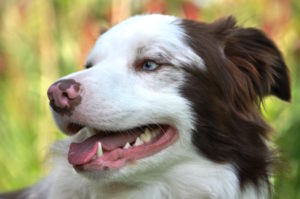
All types of species can thrive only on the diet that is appropriate for them. This is why it is critically important to identify what species your canine companion belongs to.
We will start with the statement that your dog is a carnivore. Even centuries of living with people and frequently eating table scraps and leftovers didn’t make an omnivore out of a domestic dog.
The definition of a “Carnivore” (per Merriam – Webster Dictionary):
- Any of an order (Carnivora) of typically flesh-eating mammals that includes dogs, foxes, bears, raccoons, and cats; broadly: a carnivorous animal
- A carnivorous plant the Venus flytrap and other carnivores subsisting on insects
As we stated earlier, we believe dogs are carnivores, there are a few things that attest to it:
Digestive system
- Dogs have shorter GI tract (dogs digest their meal in about 4 hours vs. human’s 6-8 hours)
- Dogs have bigger stomachs, so they can consume more in one sitting, adaptive to a “feast or famine” lifestyle, typical to a carnivore
- Dogs have higher stomach acidity level dog pH level is 1-2 (indicative of a carnivore; the same for a wolf), while a human is 4-5 (omnivore). In contrast, a goat’s (herbivore) stomach acidity is about 6.
Jaw and teeth
- Dogs chew in up-and-down chewing (chopping) motions vs. side-to-side motions (cows chew their cud with more lateral motion). When dogs eat you mainly see them breaking food into pieces just enough to get the food down the “hatch”, which often looks to us like gulping.
Dogs exhibit carnivorous behaviors:
- Digging
- Chasing (prey drive)
Dogs do not produce amylase in their saliva:
- Amylase is a digestive enzyme that helps to break down starchy carbohydrates into simple sugars before they enter the stomach.
- In carnivores, amylase is produced in the pancreas. Elevated levels of amylase in the blood are usually linked to pancreases
There is a surprisingly common discussion about whether dogs are carnivores or omnivores, but our research has lead us to believe that dogs are carnivores which adapted to living with humans. Their bodies are resilient enough so they can survive on occasional vegetarian fare (including grains) without major detrimental impact to their health, but will rarely thrive on a diet based on plant matter and carbohydrates. This is especially true as they get older.
The species appropriate diet for dogs will be a whole prey animal. The type of a prey animal can vary depending on a size of your dog. Of course, no one would expect to have a domesticated dog hunt their prey., although some dogs still do and catch an occasional squirrel, bunny, or a groundhog.
Instead of whole prey, we use a ratio of bone, muscle meat, organ, and fat ratio typically found in a whole animal to formulate dogs meals: 10% of bone, 80% muscle meat (fat ranging from 5 to 15% of the muscle meat content), 10 % of secreting organ (half of it being liver as a largest secreting organ in the body).
There is a wide-spread opinion that carnivores eat a stomach content of the prey. They do indeed, but for convenience only (it is much easier to chomp down a small prey whole). Therefore we don’t believe that feeding vegetables or grains, even in small amounts, is necessary. Eating prey stomach lining though is a completely natural behavior, so by all means you can include tripe in small amounts.
Dairy would not be normally consumed by a carnivore unless it is a mother’s milk, you suggest you forego it all together when feeding your dog.
The last but not the least characteristic of a carnivore’s diet is that it has to come mostly in its raw, un-cooked form, the fresher, the better in order to provide your dog with adequate level of nutrients and enzymes that naturally occur in raw meat.

